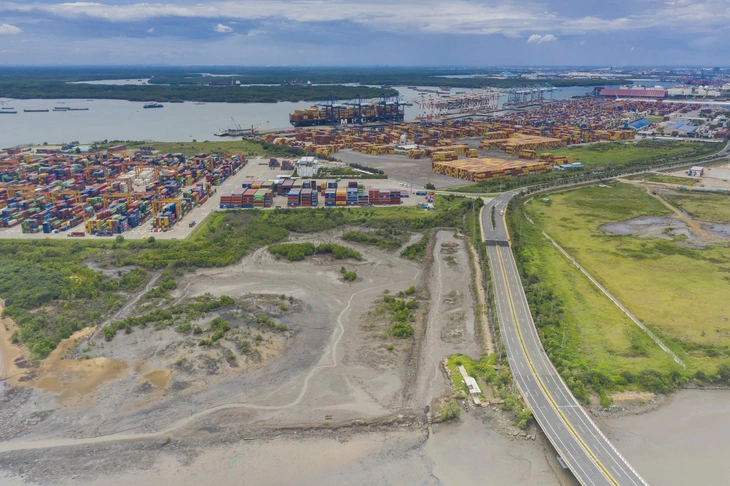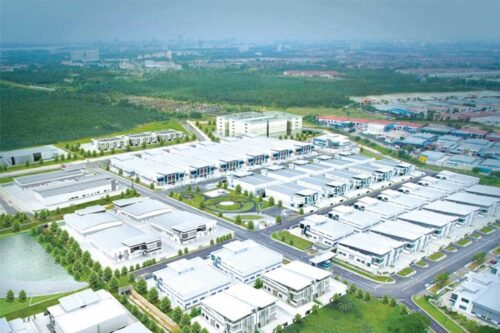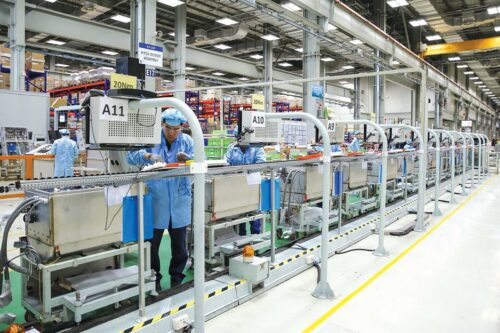By Mr. Dinh Hong Ky, published on Tuoi Tre Online, September 8, 2025.
With its strategic geo-economic position and the synergy of resources from three localities, an expanded Ho Chi Minh City has the potential to rise as one of Asia’s leading logistics hubs.

Currently, the port cluster comprising Ho Chi Minh City – Cai Mep – Thi Vai already serves as Vietnam’s largest import–export gateway, handling over 15 million TEUs annually. After the planned administrative consolidation, the new Ho Chi Minh City region will possess a “maritime triangle” that includes: the Cai Mep – Thi Vai deep-water port (Ba Ria–Vung Tau), Cat Lai port (HCMC), and in the future, the Can Gio superport (HCMC).
Opportunity to Rival Singapore in Logistics
When the Can Gio superport is completed, the region’s total container throughput capacity is projected to reach 32.7 million TEUs per year—comparable to the leading Asian port clusters. This figure nearly matches the 37.3 million TEUs handled by the Port of Singapore, the world’s second-busiest port, in 2022.
This represents a distinctive advantage for the expanded Ho Chi Minh City to position itself as the logistics gateway of Southeast Asia, competing with established centers such as Singapore and Hong Kong.
To realize this ambition, a prerequisite is to establish truly efficient interregional logistics connectivity. The deep-water ports in Cai Mep–Thi Vai are already capable of accommodating mother vessels bound directly for Europe and the United States (the largest in Vietnam), with a combined capacity of 10.8 million TEUs per year.
However, the current shortcoming lies in the inadequate connection between these ports and inland areas. The road link from Cai Mep to Ho Chi Minh City still depends on National Highway 51, which is frequently congested, and the ring road system linking the ports remains incomplete.
Therefore, priority should be given to completing the Bien Hoa – Vung Tau Expressway, the Phuoc An and Nhon Trach bridges, and Ring Road 3 to directly connect the Cai Mep port cluster with the Southern Inter-Regional Expressway Network, establishing an uninterrupted logistics corridor. In parallel, accelerating the construction of Ring Road 4 will allow container trucks to bypass residential areas and directly connect industrial zones in Binh Duong, Dong Nai, and Long An to the seaports.
In addition to road infrastructure, inland waterways must be revitalized. For instance, the Dong Nai – Sai Gon – Cai Mep river route could become a “waterway expressway” for transporting containers by barge from inland container depots (ICDs) in Thu Duc and Binh Duong to the seaports, thereby easing pressure on roads.
Development of Inland Logistics Hubs
Developing inland container depots (ICDs) in the industrial zones of Binh Duong and Dong Nai is essential. Binh Duong currently has the Song Than ICD, while Dong Nai has the Long Binh ICD, though both are still limited in scale. The new Ho Chi Minh City region should plan a comprehensive network of domestic logistics hubs, including 2–3 large ICDs along Ring Road 3 (located in Binh Duong and Thu Duc City) and near the industrial clusters in the western area (Duc Hoa – Long An).
These ICDs would consolidate cargo from factories, allow customs clearance onsite, and transport containers to seaports on scheduled routes.
This model mirrors the logistics system of Los Angeles, where the twin ports of Los Angeles and Long Beach handle over 20 million TEUs annually—accounting for 40% of the U.S. import container volume—thanks to a network of railways and expressways connecting directly to inland logistics hubs in the Inland Empire region, along with vast warehouse systems supporting goods distribution.

Similarly, an expanded Ho Chi Minh City could develop Vietnam’s own “Inland Empire” across Binh Duong and Dong Nai, hosting hundreds of warehouses and distribution centers linked to expressway networks that facilitate the flow of goods across North–South Vietnam and into Cambodia and Laos.
Smart and Green Logistics
Another key pillar in becoming a top-tier Asian logistics gateway is the robust application of technology and intelligent supply chain management. Ho Chi Minh City should aim to build “smart ports” at Cat Lai and Cai Mep following global best practices.
For example, the Port of Los Angeles has adopted artificial intelligence, automation, and blockchain in container management—enhancing efficiency and reducing container dwell time from three days to just 24 hours.
The twin ports of Los Angeles and Long Beach employ automated cranes, autonomous vehicles, and real-time container tracking systems to optimize cargo flow. Similarly, Singapore’s new Tuas Port is the world’s largest automated port, utilizing robotic cranes and AI-driven systems to achieve record-breaking throughput.
The new Ho Chi Minh City can invest in comparable systems—such as automated quay cranes, driverless container transport vehicles, and AI-powered ship arrival forecasting and yard planning systems.
A regional smart logistics operations center should also be established to integrate data from ports, warehouses, enterprises, and customs authorities. This will enable businesses to track shipments in real time, conduct electronic customs procedures, and coordinate transport schedules more efficiently.
In addition, the development of green logistics is an inevitable trend and a competitive edge that Ho Chi Minh City should leverage. With Ba Ria–Vung Tau emerging as a new energy hub (offshore wind power and LNG), the region could pioneer the use of clean fuels for maritime shipping (such as LNG and hydrogen).
Ho Chi Minh City could deploy electric or compressed-gas trucks for short-haul transport between ICDs and ports. Any new railway projects should utilize electric locomotives. Reducing emissions in logistics not only helps protect the urban environment but also fulfills ESG requirements from multinational corporations—an increasingly important factor in global supply chains.
Regional Linkages to Expand the Logistics Hinterland
The Ho Chi Minh City – Binh Duong – Ba Ria–Vung Tau triangle forms a complete economic cluster. Industrial production is concentrated in Binh Duong (61 industrial zones, 24,800 hectares), energy exports and maritime trade are handled through Ba Ria–Vung Tau, while Ho Chi Minh City serves as the commercial and financial hub. This structure forms a closed-loop supply chain within the region, minimizing dependence on external gateways.
Nevertheless, the new Ho Chi Minh City must also proactively connect with neighboring provinces to expand its logistics hinterland. For instance, cooperation with Dong Nai and Long An could facilitate the development of river port networks along the Dong Nai and Vam Co rivers, enhancing cargo transport from the Central Highlands and the Mekong Delta to the HCMC port cluster.
Moreover, Ho Chi Minh City could act as a land-based ASEAN logistics coordination center, capitalizing on the trans-Asian economic corridor (HCMC – Phnom Penh – Bangkok) to transship goods between Thailand, Cambodia, and Vietnam’s seaports.
If the proposed HCMC–Can Tho and HCMC–Phnom Penh railway projects are implemented in the future, the city could evolve into a regional rail logistics hub, linking trade flows between China, ASEAN, and the East Sea.
To become an Asian gateway, Ho Chi Minh City will inevitably face competition from major logistics centers such as Singapore, Bangkok, and Hong Kong. Singapore remains the world’s No.2 transshipment port due to its geographic location and world-class service ecosystem.
Ho Chi Minh City’s strength lies in its vast industrial hinterland and large domestic market—advantages Singapore lacks. Therefore, instead of competing head-to-head as a global transshipment center, Ho Chi Minh City should focus on serving as the primary logistics gateway for Vietnam and the Indochinese Peninsula.
At the same time, the city can attract global shipping lines to invest in and operate terminals at Cai Mep and Can Gio, drawing new cargo flows.
China’s experience offers a valuable lesson: Shanghai became the world’s largest port not by defeating Hong Kong, but by effectively serving China’s massive domestic market and ensuring seamless inland connectivity.


